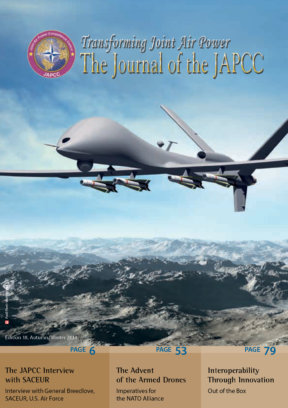Introduction
The end of the Cold War brought an increase in NATO’s reliance on Air Power as NATO and the Alliance nations have repeatedly turned to Air Power as their first, and in some cases only, military response option.
Heavy and long term land operations are neither financially feasible nor politically sustainable. Thus, the need for responsive and flexible Air Forces and Naval Air services remains valid. NATO must retain and improve its Air and Space Power capabilities if it is to successfully meet future challenges. Thus, the change required to retain Air and Space Power superiority must primarily come from policy and strategy, not from acquisition of increasing sophisticated and costly technology.
In an effort to cut military budgets, NATO nations risk reduction of not just the number of assets but their Air Power capabilities too. From the end of the Cold War, this reduction has continued at a pace giving cause for concern. The near-term cessation of combat operations in Afghanistan, in combination with the on-going financial cuts, makes certain that investment in future Air and Space Power (A&S) capabilities will be subjected to close scrutiny and will most likely be further reduced.
Compared to land warfare, however, airpower is still the cheaper solution. As a result of continued operations in Afghanistan, NATO nations have often tailored their air assets to support COIN operations reducing strategic capabilities. How can NATO and its member nations meet anticipated future Air Power requirements?
There is a temptation during times of austerity for nations to become introspective and focus exclusively on national priorities at the expense of multi-national co-operation. What other difficulties exist in realising A&S transformation and how can we overcome them? Is present NATO policy and structure (NDPP, SMART Defence, command structure etc.) enough to face future challenges? Maybe we are still stuck in ‘old thinking’ mode, and it might be reasonable to shift efforts by adapting requirements to newly developing threats and strategy.
Times Have Changed. Have We?
Conflicts, wars, and warfare of the 2000s had a political character such that the matching violence was of an irregular kind. The dominant strategic narrative for airpower has reflected the paradigm of state on state, regular-combat-style warfare. The World’s major air forces have been shaped overwhelmingly to meet the needs attendant upon regular forms of warfare. From time to time air forces have been obliged to address the challenges of irregular war, but the expertise and much of the equipment tailored to those particular tasks have tended to be fleeting capabilities and competencies. So talking about ‘irregular’ or ‘hybrid’ war may raise the question: Do we still develop, buy, and use the right weapon systems? The relative significance of the air contribution to the joint fight certainly has shifted from one war to the next over the last decade.
From a political perspective, ethical and / or economic reasons, the public is less willing to accept operations that require friendly troops on the ground. In that respect, A&S Power may be seen as the preferable means to solve future challenges. Boots on the ground, resulting in military casualties, nowadays is unacceptable. Airpower however, guarantees minimal loss of friendly troops.
National vs. NATO Interests
In times of economic constraint, nations will give priority first to their own national interest then to the alliance interest. Article 5 scenarios are generally accepted without regard to legitimacy. Not all nations will join a ‘coalition of the willing’, if theatres of war, warring factions and political / ethnical / religious aims are not widely accepted. We have to face the fact that southern countries will be interested more in the Mediterranean challenges with little focus on the ‘pacific arena’; eastern counties are concerned about their relationship with former USSR nations; northern Europe nations have different approach on foreign policy (expeditionary versus non-expeditionary); the US have already moved their attention to Asia; how will all this affect future airpower policies? The 2011 Libyan war provides a likely blueprint for many future NATO operations. During the conflict, the US took on a limited, supporting role for the first time, leaving its European allies in a leadership role. Primarily under French and British command, NATO forces were indispensable in helping the Libyan rebels to topple Muammar Gaddafi. NATO’s European members realised that the essential bargain underlying their alliance with the US had changed. Ideally national interests should match Alliance interests.
Air Power’s Relavance
Airpower does not solely mean dropping bombs and engaging hostile fighter aircraft. It is universally, ubiquitously and strategically useful. There is an air narrative integral to every conflict. Rather foolish doubts with respect to airpower’s strategic value in the past have tended to obscure the more significant reality of airpower’s true pervasiveness. Coming back to Afghanistan, airpower provides an air bridge for mobility both to and within the country, provides and supports all C4ISTAR functions, delivers essential medevac services, and both manned and unmanned platforms provide agile precise fire power. Lessons Learned from Afghanistan are surely relevant for future asymmetric conflicts but they are not the sole paradigm.
If we still are convinced that air power is the primary tool for today’s warfare, we have to use our valuable assets and invaluable competencies in the smartest way. We are sure that reducing numbers will be acceptable, loosing core competencies is not! In implementing new solutions for air power, the challenge is now to get the most out of our investments. Will improved range and speed play a central role in a successful Air Force strategy? Will the integration of air, space and cyber capabilities across domains become the key enabler for the coming decades? Will we be able to sustain our competencies and advantage?











